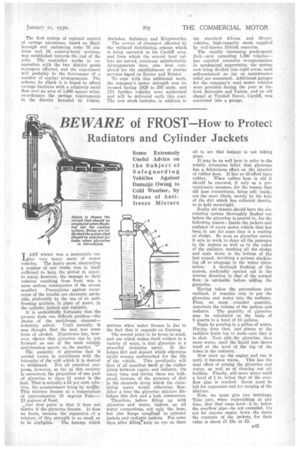G.W.R. Goods Road-service Developments
Page 68

Page 69

If you've noticed an error in this article please click here to report it so we can fix it.
FROM a lengthy review of the work of the past year drawn up by the goods department of the Great Western Railway Co. we learn that there was a substantial increase in the tonnage of road deliveries and collections during the 12 months. The company's cartage equipment dealt with an increased goods traffic as compared with 1928 of nearly 250,000 tons, also nearly a million additional passenger-train parcels.
The road transport of rail-borne traffic included 3,250 tons of timber at Dulverton, 4,000 tons of ashes At Exeter, more than 2,000 tons of pipes at both Flax Bourton and Pembrey, 2,500 tons of general material for the new generating station at Portishead, 1,000 tons of bricks and lime at
B42 Coekett, 5,800 tons of gravel at Oswestry, and large quantities of cable; many other large and important contracts were handled.
The efforts made by the company to provide adequate haulage facilities for the sugar-beet crop were highly successful, the tonnage carried, including both that from farm to factory and that from farm to railway station, much exceeding the total of the previous year. Satisfactory contracts were also concluded for door-to-door road transport of many types of traffic for which rail transit was not convenient, including 369,000 gallons of milk from Badminton, and other places, to Frampton, over 5,000 tons of sand and gravel from Theale pits, and quantities of sugar from the London Docks. An experi
mental film service between cinemas was also inaugurated.
The already established " countrylorry " centres were augmented during the year by 32 new services, practically every square mile of the territory served by the company being now brought in contact with one or another of the G.W.R. stations by motor lorry, and that at low rates. The contracts at 26 stations with cartage agents were determined in favour of the company's own equipment as the new countrylorry services were established. It is added that these services constitute, in themselves, an additional source of revenue and are providing a vital link between the railway and the countryside. As many as 120 of such services are worked over G.W.R. system. The first system of regional control of cartage operations, based on Marlborough and embracing some 76 stations and 16 country-lorry services, was established towards the end of the yelir. The controller works in cooperation with the two district goods managers affected, and the experiment will probably he the forerunner of a number of similar arrangements. The scheme, by iihich it is hoped to afford cartage facilities with a relatively small fleet over an area of 1,000 square miles, co-ordinates the cartage requirements in the district bounded by Dideot, Swindon, Salisbury and Kingsworthy.
The service of transport afforded by the railhead distribution scheme which is being operated in the Cardiff area and from which the several local valleys are served, continues satisfactorily. Arrangements have also been completed for the establishment of similar services hived on Exeter and Bristol.
To cope with this additional work, the company's motor strength was increased during 1929 to 287 units, and 170 further vehicles were authorized and will be delivered early this year. The new stock includes, in addition to the standard 4-5-ton and 80-cwt. vehicles, high-capacity stock supplied by well-known British concerns.
The rapidly increasing goods-motor fleet—now exceeding 1,300 vehicles— has entailed extensive re-organization in mechanical supervision, the -system now being divided into eight areas, eac.h self-contained so, :atr as • maintenance relief are concerned. Additional garages for the company's • road motor vehicles were provided. during the year at Oxford, ,Salcombe and Yatton, and an old chapel at Tyndall Street, Cardiff, was converted into a garage. •




















































































































